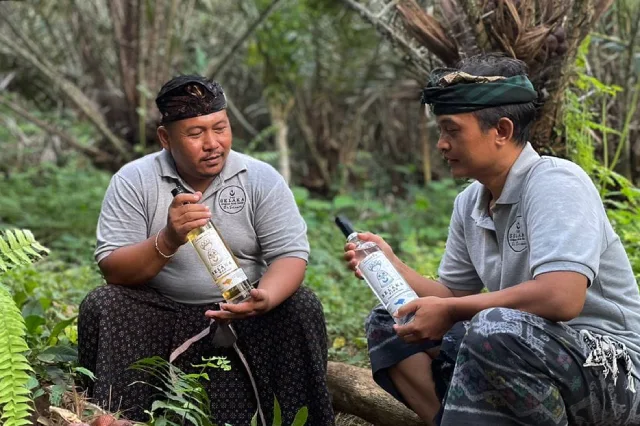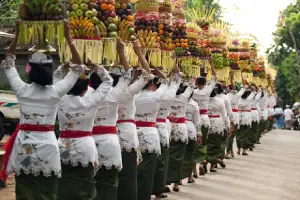Things to Do in Bali
The History of Bali – Island of the Gods
Gaining a deeper understanding of Bali’s culture and history significantly enriches your travel experience, allowing you to engage on a deeper and more authentic level with the island’s unique traditions, arts, spirituality and people. Why are there so many temples, why has Bali been so resilient to the outside influences, what are their values, how have they managed to preserve their culture and art withstanding the waves of mass tourism, and why is Bali at the same time under threat.
Bali’s history can be traced back to the Stone Age, with early cultural influences recorded through ancient artifacts and inscriptions. Bali’s culture and history cannot be understood without linking it with it’s larger sister-island JAVA.
The original Balinese people are believed to descend from Austronesian-speaking migrants who came to Bali thousands of years ago, likely from Taiwan or Southeast Asia, predating the arrival of Hindu-Javanese influence by centuries. These early settlers are linked to the broader Austronesian migrations, which spread seafaring, agricultural, and cultural knowledge across the Pacific and Indian Ocean regions, reaching as far as Madagascar and Easter Island.
1. Ancient Balinese Origins & Influence
Austronesian Migration
Evidence shows that these early Balinese communities shared cultural and linguistic roots with other Austronesian populations, characterized by a strong emphasis on agriculture, especially wet-rice farming, which remains central to Balinese society.
Distinct Cultural and Spiritual Practices
Unlike the Hinduism brought India as early as the first century and brought from Java particularly in the 11th-16th centuries, early Balinese spiritual life centered around animistic beliefs, ancestor worship, and a strong reverence for nature and spirits. While Hinduism transformed these beliefs, the integration led to Bali’s unique “Agama Hindu Dharma,” a syncretic faith combining elements of native animism and imported Hindu practices.
Subak System
The ancient Balinese also developed the subak irrigation system, a complex and community-managed water distribution system, which UNESCO recognizes as a World Heritage practice. This system reflects the cooperative and spiritually tied approach to agriculture rooted in Balinese identity long before Hindu influence.
Bali’s Linguistic Heritage
The Balinese language, part of the Malayo-Polynesian language family, retains aspects distinct from Javanese, though centuries of cultural exchange with Java have introduced some linguistic influences.
The arrival of Hindu-Javanese refugees and royalty, particularly during the 14th-16th centuries with the fall of the Majapahit Empire, introduced new religious, artistic, and architectural influences. These layered onto the existing culture, enhancing the island’s spiritual, social, and cultural fabric. The resulting Balinese identity thus draws from both indigenous Austronesian traditions and centuries of Hindu-Javanese contributions, creating a distinct, rich heritage unique to Bali.
Bali’s distinctive cultural heritage therefore began to develop significantly during the Majapahit Empire (1293 to 1520 AD). This period saw the spread of Hindu-Javanese traditions, literature, and artistic practices from Java to Bali, especially after the fall of Majapahit. The empire, led at its peak by the renowned ruler Hayam Wuruk with his prime minister Gajah Mada, expanded its influence over much of the Indonesian archipelago, including Bali, the southern Malay Peninsula, Borneo, Sumatra, Kalimantan, and parts of eastern Indonesia.
Following the empire’s gradual decline in the 15th century, a major exodus of Hindu priests, artists, intellectuals, and members of the Javanese royal family migrated to Bali. This migration helped solidify Bali as a stronghold of Hindu culture, which flourished on the island and shaped much of its present-day arts, literature, and customs.
Hinduism and Bali
The introduction of Hinduism to Bali was a gradual process influenced both by early Indian contact and, significantly, through the later influence of the Javanese Majapahit Empire.
1. Early Indian Influence (circa 1st – 7th centuries)
Trade and Early Contact
Indian traders arrived in the Indonesian archipelago, including Bali, as early as the 1st century. They established trading routes and cultural exchange points, particularly in Sumatra and Java. These traders brought with them elements of Hinduism and Buddhism, leading to the early adoption of Hindu and Buddhist iconography, social customs, and Sanskrit inscriptions. By the 7th century, these influences had extended to Bali, where Sanskrit inscriptions have been found, signifying the early spread of Hindu religious ideas and practices.
Balinese Adaptation of Hinduism
Early Hindu practices in Bali were adapted to local animistic and ancestor-worshipping beliefs, creating a unique blend of Hindu-Balinese spirituality that differed from Indian Hinduism. However, these early influences were relatively limited in scope and did not establish the full framework of Hindu culture in Bali.
2. The Role of the Majapahit Empire (14th – 16th centuries)
Majapahit Conquest (1343)
The Majapahit Empire in Java, particularly under the leadership of Gajah Mada, launched a series of conquests throughout the archipelago, including Bali. In 1343, the Majapahit forces formally conquered Bali, bringing with them a stronger and more structured form of Hinduism and Javanese culture. This conquest established Bali as a vassal state of the Majapahit Empire and led to increased immigration of Javanese Hindu nobles, priests, artists, and intellectuals to Bali.
Exodus of Hindu-Javanese Elites
As Islam spread in Java in the 16th century, particularly with the rise of the Demak Sultanate, a large-scale migration of Hindu-Javanese elites, including royal families, priests, artists, and scholars, occurred. These individuals sought refuge in Bali, bringing with them advanced practices of Hinduism and further influencing Balinese culture. The result was a deepening of Hindu rituals, social structures, and art forms, with Bali becoming a sanctuary for the preservation of Majapahit Hindu culture.
3. Lasting Cultural and Religious Impact
Formation of Balinese Hinduism
The integration of Indian-origin Hinduism and the structured practices of the Majapahit Hindu-Javanese form created the unique Agama Hindu Dharma practiced in Bali. This version of Hinduism adapted Indian deities, Javanese philosophical principles, and local Balinese animistic practices into a cohesive system.
While Indian traders introduced Hindu elements to Bali, the Majapahit Empire’s conquest and subsequent Hindu-Javanese migrations were crucial in establishing a more organized and culturally pervasive form of Hinduism. It was the Majapahit influence that solidified Hinduism in Bali’s social structure, religious practices, and arts, shaping it into the unique form seen today.
The Majahapit in Bali
In the 16th century, Bali became a refuge for Hindu-Javanese people as Islam rapidly spread through Java, culminating in significant changes to Balinese society, culture, religion, and governance. This influx of Hindu-Javanese people following the collapse of the Hindu Majapahit Empire in Java created an indelible influence on Bali. Here’s a breakdown of the migration’s significance:
Historical Context of Migration
Fall of Majapahit in Java
The Majapahit Empire, a dominant Hindu kingdom in East Java, began to decline in the early 16th century as Islam gained influence. By 1520, Islamic sultanates replaced Hindu dynasties across Java, pushing Hindu nobles, priests, artists, and warriors to Bali. Many sought to preserve their religious, artistic, and cultural practices, seeing Bali as a safe haven for their Hindu traditions.
Formation of Balinese Kingdoms
Bali’s existing kingdoms—such as those in Klungkung and Gianyar—were deeply influenced by the Majapahit culture, literature, governance systems, and religious practices. This migration fortified these kingdoms, eventually establishing a structured society where Bali served as a custodian of the Majapahit Hindu-Javanese legacy.
Majahapit Influence on Balinese Culture and Society
Hinduism and the Caste System
The Hindu-Javanese brought a refined caste system to Bali, categorizing society into distinct roles and responsibilities. This adaptation of Hinduism to local traditions led to the Balinese “Catur Varna” system, akin to the Hindu caste system but distinct in its integration with indigenous Balinese customs. The four major castes—Brahmana (priests), Ksatria (warriors), Wesia (merchants), and Sudra (farmers)—were adapted with flexibility in Bali but still held a significant social and spiritual role.
Bali Caste System
Religious and Ritual Significance
Hindu-Javanese priests, such as Dang Hyang Nirartha, introduced religious concepts, rituals, and sacred architecture. Nirartha, for instance, built iconic temples like Uluwatu and Tanah Lot, which became central to Balinese Hindu worship and reinforced Bali’s temple-based spiritual landscape. The importance of pujawali ceremonies, honoring Hindu deities through elaborate temple rituals, took root during this era.
Governance and Arts
Balinese Kings and Governance
The Majapahit influence strengthened Bali’s governance systems. Kings in Bali emulated Javanese practices of centralized rule, with Klungkung becoming the paramount kingdom, presiding over lesser realms. The “Dalem” kings in Bali upheld Hindu law and ritual practices that were deeply intertwined with governance, making the king both a political and spiritual leader.
Cultural Flourishing
This period of Hindu-Javanese migration sparked a golden age in Balinese arts. Dance, music, sculpture, and literature were influenced by Javanese Hindu epics such as the Mahabharata and Ramayana. Additionally, Bali’s iconic shadow puppet theater (wayang kulit) and traditional dances were adaptations of Javanese performance art, blending Hindu religious themes with local Balinese stories.
Long-Lasting Legacy of the Majahapit
Cultural Preservation
While the spread of Islam in Java nearly eradicated Hindu practices there, Bali preserved and adapted Hinduism, creating a unique “Agama Hindu Dharma” tradition. This religion, distinct from Indian Hinduism, integrated local animistic beliefs, reverence for nature, and ancestor worship, which remain central to Balinese life today.
Resilience of Balinese Identity
The migration from Java allowed Bali to become a last stronghold of the Majapahit legacy, imbuing Balinese culture with a sense of historical pride and spiritual heritage. The caste system and religious traditions established by the Hindu-Javanese continue to shape Balinese society, temple rituals, and village governance, making Bali an exceptional case in the Indonesian archipelago.
This significant period remains vital in understanding Bali’s religious practices, social structure, and its lasting role as a center of Hindu culture within Indonesia. The integration of Javanese traditions provided a resilient foundation that has allowed Bali to preserve and celebrate its unique heritage across centuries.
4. Dutch Colonial Expansion in Indonesia and Its Impact on Bali
The Dutch began their expansion into the Indonesian archipelago in the early 17th century, initially focusing on Java and the Spice Islands (Maluku) to control lucrative spice trade routes. Through the Dutch East India Company (VOC) and later direct rule by the Dutch government, they gradually formed the Dutch East Indies. However, Bali remained largely independent and resistant to colonial control well into the early 20th century.
A Stalemate in Bali
Unlike Java, Bali’s fiercely autonomous kingdoms consistently pushed back against Dutch encroachment. From the 1840s onwards, the Dutch launched several military campaigns — including their 1846 invasion of Buleleng in North Bali — but the Balinese responded with fierce resistance. This resulted in a political and military stalemate, and for decades, Bali remained outside full Dutch control. The Dutch instead turned their attention to easier targets across the archipelago, postponing deeper involvement in Bali.
Maritime Conflicts and Renewed Dutch Interest
By the early 1900s, however, Dutch patience had worn thin. A growing number of incidents involving shipwrecks off Bali’s southern coast — followed by the looting of cargo and passengers by local forces — gave the Dutch what they considered a justification for reasserting authority. These provocations, whether exaggerated or legitimate, led to renewed military intervention.
The Tragic Puputan of 1906 – Badung
In 1906, the Dutch launched a full-scale military operation against the southern kingdom of Badung (present-day Denpasar). Rather than surrender, the Raja of Badung, along with his court, nobles, and followers — nearly 3,000 people — prepared for puputan, a ritual mass suicide. Dressed in ceremonial white, they marched silently toward the Dutch. Following tradition, a priest killed the Raja to prevent his capture, after which the Balinese turned on themselves and each other, killing one another with kris daggers in a collective act of sacrifice and defiance. The Dutch barely fired a shot. This self-inflicted mass death left the colonial troops stunned and horrified — a psychological and symbolic resistance, profoundly different from later armed confrontations.
The Puputan of 1908 – Klungkung
A second mass puputan followed in 1908, when Dutch troops moved to annex the royal court of Klungkung — the island’s spiritual and political center. Again, the Balinese aristocracy chose death over submission. These two events — marked by extraordinary symbolism and cultural significance — became foundational moments in the modern identity of Bali. To this day, puputan is remembered not as defeat, but as a sacred expression of honor, loyalty, and resistance.
“Preserve, Don’t Destroy”: A Colonial Shift
Shaken by global condemnation and the trauma of the puputans, the Dutch opted for a new approach. Instead of enforcing Java-style colonial bureaucracy, they repositioned themselves as protectors of Balinese culture. Bali was marketed as a “living museum” — a repository of pre-Islamic, Hindu-Javanese tradition. This contradiction — colonization wrapped in cultural preservation — attracted early anthropologists, artists, and romantic travelers. It laid the groundwork for what would eventually become Bali’s first wave of tourism.
World War II: Japanese Invasion and Nationalist Awakening
In 1942, during World War II, Japan invaded Bali as part of its rapid conquest of Southeast Asia. Dutch forces were quickly overrun, and Japanese rule over the island began. The occupation was brutal, marked by forced labor, food shortages, and strict control. Yet it also had a profound and unexpected consequence: it shattered Dutch authority and allowed nationalist movements to grow.
Importantly, Sukarno — who had been imprisoned by the Dutch — was released during the Japanese occupation and allowed to organize politically. Japanese propaganda encouraged pan-Asian unity and independence, helping to shape a growing Indonesian nationalist consciousness — including among Balinese youth.
The Japanese occupation was short but pivotal: it broke the illusion of European dominance and prepared the ground for Indonesia’s next transformation.
1945 Declaration of Independence
When Japan surrendered in August 1945, Sukarno and Mohammad Hatta declared Indonesia’s independence on August 17. But the Dutch, eager to restore control, returned with military force in 1947 — backed in part by U.S. Marshall Plan funds.
The Puputan Margarana – 1946
One of the final and most symbolic acts of resistance occurred in 1946 in central Bali. I Gusti Ngurah Rai, a Balinese nationalist commander, led his forces in what would become the Puputan Margarana. Unlike the 1906 puputan, which was a ritual collective suicide, the 1946 puputan was an armed military charge — a direct assault on Dutch troops, in full knowledge it would end in death. All of Rai’s men were killed, and he became a national hero. Bali’s international airport now bears his name.
Global Pressure and Dutch Withdrawal
Between 1945 and 1949, the Dutch failed to regain full control. Indonesian resistance, both political and military, remained strong — and international opinion shifted. When it became known that the Dutch were using U.S. Marshall Plan funds to finance military operations in Indonesia, the United States pressured the Netherlands to cease its campaign.
Indonesian Sovereignty – 1949
In December 1949, the Netherlands officially recognized Indonesian independence. Bali was later integrated into the republic as a province in 1958.
From Sukarno to Suharto: Geopolitics and Development
Sukarno, Indonesia’s first president, positioned the country as a non-aligned power during the Cold War. He resisted both Western and Soviet influence and promoted a vision of Indonesian unity and independence. While admired by many in the Global South, his anti-imperialist stance and nationalization of foreign businesses made him unpopular with the United States.
Indonesia’s vast natural resources made it a geopolitical prize. In 1965, a coup and counter-coup — with alleged CIA backing — brought Suharto to power. Suharto aligned Indonesia with Western economic interests and received significant funding from the World Bank and IMF.
Under his New Order regime, massive infrastructure and tourism development projects were launched — especially in Bali, which became the flagship destination of Indonesia’s economic modernization. This marked the beginning of the island’s transformation into one of the world’s most visited cultural and spiritual tourism hubs.
By 1949, international pressure and the Indonesian National Revolution forced the Netherlands to formally recognize Indonesia’s independence. Bali became part of the Republic of Indonesia, and it was fully integrated into the nation as a province in 1958.
The Beginning of Tourism in Bali
Early Beginnings
Early 20th Century and Tourism Beginnings
- 1912: German photographer Gregor Krause’s images of Bali spark Western fascination. His work portrays the island’s unique culture and landscape, setting the stage for early tourism. The Dutch colonial administration begins promoting Bali as an exotic destination, especially focusing on the northern region of Singaraja.
- 1930s: Artists and writers like Walter Spies and Miguel Covarrubias arrive in Bali, intrigued by its culture. Spies, a German painter, documents Balinese life and nature in his works, influencing perceptions of Bali as an artistic haven. His collaborations with anthropologist Margaret Mead and painter Rudolf Bonnet help establish Ubud as a center for art and culture.
- 1932: Charlie Chaplin visits Bali during a trip across Asia, capturing international attention. Chaplin’s accounts and admiration for Balinese culture further heighten Bali’s allure as a remote paradise, drawing travelers with an interest in the arts and anthropology.
- 1936: Americans Robert and Louise Koke open the Kuta Beach Hotel, one of Bali’s first accommodations aimed at international travelers. This new venture shifts tourism from the north to Kuta, making it an early tourist hub.
- 1940s: World War II halts tourism in Bali. Following the Japanese occupation of Indonesia from 1942 to 1945, Bali becomes a part of Indonesia’s national struggle for independence from Dutch colonial rule.
- 1950s: After independence, President Sukarno promotes Bali as a cultural showpiece of Indonesia, encouraging tourism to showcase national heritage. Limited infrastructure, however, keeps tourism growth slow.
- 1963: The eruption of Mount Agung, Bali’s sacred volcano, devastates villages and temples. Thousands are displaced, 1,500 people die, and the eruption causes a temporary decline in tourism .
- 1969: The Indonesian government completes Ngurah Rai International Airport, significantly enhancing Bali’s accessibility. This infrastructure improvement spurs a new wave of international visitors.
- 1970s: Bali experiences a tourism boom, especially from Australian surfers and backpackers drawn to Kuta Beach. With more hotels and bungalows catering to tourists, Kuta develops into a vibrant area known for its surf culture.
- 1983: Seminyak begins to gain popularity and within a decade gets established as an upscale destination. While Kuta remains famous for surf and nightlife,
- 2002: The Bali bombings in Kuta by Jemaah Islamiyah shock the island and the world. The attacks, which kill over 200 people, lead to a drastic decline in tourism and raise security concerns. The Indonesian government increases security measures, and tourism rebounds with continued support from international communities.
- 2000s: The rise of Chinese tourists significantly impacts Bali’s economy. Bali’s popularity grows in China, leading to dedicated flights and packages catering to Chinese visitors.
- 2005: Another bombing strikes popular tourist areas in Kuta and Jimbaran, causing a temporary drop in visitor numbers. Tourism gradually recovers as Bali reinforces its image as a peaceful and safe destination.
- 2009: Ngurah Rai International Airport undergoes a major expansion to accommodate Bali’s tourism growth. The airport’s expansion boosts its capacity to handle millions more tourists annually, further strengthening Bali’s position as an international travel hub.
- 2010: The release of the movie Eat Pray Love, starring Julia Roberts, reignites interest in Bali as a place for personal transformation and wellness tourism. Ubud, in particular, gains a reputation as a retreat for yoga and holistic healing.
- 2013: Bali Mandara Toll Road opens, easing traffic as Bali hosts the APEC Summit, establishing itself as a prime Southeast Asian hub.
- 2016: The Rise of Canggu, once a quiet village, within a few years develops into a trendy spot known for eco-conscious cafes, surf schools, and co-working spaces, beach clubs. WHere there were rice fields 10 years ago, there is now tourism and not enough roads. Its rise attracted digital nomads, investors, and travelers who wish to live in Bali more permanently. Yet at this massive explosion of tourism eating into lagricultural land triggered the discussion whether Bali is losing its cultural heritage and is finally overdeveloped
- 2017: Mount Agung erupts again, causing temporary evacuations and travel disruptions. The eruption has a limited long-term impact on tourism, but reinforces the importance of disaster preparedness on the island.
- 2020: The COVID-19 pandemic causes a major setback, with international arrivals halting due to global travel restrictions. The Balinese economy and therefore the Balinese, heavily reliant on tourism, suffer greatly, prompting discussions on sustainable tourism and economic diversification.
- 2021: Delta variant causes a second wave, overwhelming hospitals. Vaccination campaigns and strict regulations aim to curb the spread of the virus.
- 2022: As travel restrictions ease, Bali reopens to international tourism With global travel resuming, Bali begins to recover. Sustainable tourism initiatives gain momentum, focusing on eco-friendly practices, cultural preservation, and support for local communities.
Bali Today
Bali’s journey is one of resilience, adaptation, and cultural preservation. From ancient roots and colonial resistance to embracing tourism and modern challenges, the Balinese people remain deeply connected to their traditions. Today, Bali still stands as a beacon of culture, spirituality, and natural beauty, facing the challenge of balancing modernity with its rich heritage.
























